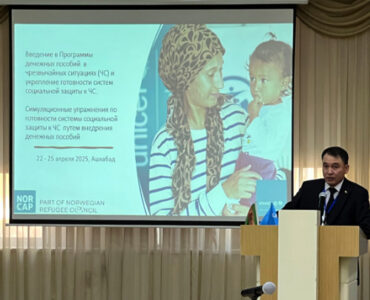A new report by the World Bank, titled “Unlivable: How Cities in Europe and Central Asia Can Survive and Thrive in a Hotter Future”, explains how extreme heat will increasingly affect cities across Europe and Central Asia, posing severe threats to human health, economic productivity, and infrastructure. Turkmenistan is among the most at-risk countries, with some of the sharpest increases in the number of extreme heat days (doubling) and productivity losses of up to 5%.
Rising temperatures and extreme heat
The report projects that the number of extreme heat days will rise dramatically by 2090. Extreme heat day is defined as a day when the wet-bulb globe temperature (WBGT) exceeds 30.5°C, a threshold considered dangerous, especially for outdoor activities in the sun.
For Turkmenistan, the report estimates the following:
- In Turkmenabat, the number of such days per year is expected to rise from 45 in 2015 to 66 days in 2030, 80 days in 2050, and 96 days in 2090.
- In Dashoguz, the number is projected to increase from 41 days in 2015 to 56 days in 2030, 67 days in 2050, and 80 days in 2090.
These figures are based on the SSP2-4.5 emissions scenario, which assumes moderate climate action. Without stronger emission reductions, the numbers could be even higher.
The report also highlights the growing health and mortality risks from extreme heat, especially for older populations, who are more vulnerable to heat-related illnesses and deaths. In Ashgabat, relative risks of heat-related deaths are the highest among Central Asian capitals.
In cities with already hot climates such as Ashgabat (Turkmenistan), Baku (Azerbaijan), Lasi (Romania), and Osijek (Croatia), heat-related mortality rates in 2000-2020 ranged from 25 to 27.5 deaths per 100,000 people. These rates are expected to only increase in the future.
Donate to support Turkmen analysts, researchers and writers to produce factual, constructive and progressive content in their efforts to educate the public of Turkmenistan.
SUPPORT OUR WORKApart from health and mortality, extreme heat also affects the economy. The report estimates that the heat stress is projected to reduce the number of working hours, particularly in countries with hotter climates and high-intensity jobs. Projections for Turkmenistan show that almost 5% of working hours in the construction sector could be lost by 2050 due to heat stress. In the industrial sector, projected losses are about 2%, and in services, around 0.1%.
By 2050, Ashgabat is projected to be one of 9 cities across the region with urban productivity losses of 2% or more. The other cities are located in Türkiye, Cyprus, and Greece.
The report also warns that urban infrastructure is vulnerable to rising temperatures and extreme heat events. Impacts include:
- Road damage due to softening asphalt and the formation of potholes;
- Deformation of rail lines;
- Overheating and mechanical failure of buses and trains;
- Power system failures due to increased cooling demand, causing further disruptions to essential services such as water pumping and healthcare.
Buildings are another major concern. Much of the building stock in Europe and Central Asia, including Turkmenistan, was designed for colder climates. Many structures in Central Asia are built with concrete that retains heat and has poor insulation, in addition to having leaky windows and uninsulated walls and roofs, leading to heat gain in summer and heat loss in winter.
Actions for more resilient urban areas
To address these challenges, the report outlines 10 key actions for reducing exposure to heat, protect public health, and strengthen urban systems:
- Advance urban greening: use drought-tolerant plants, harvest rainwater, and plan development of green, shaded areas in the long-term (10-20 years).
- Harness wind, shade, and design: plan urban layouts to promote airflow, reduce building density, and integrate natural ventilation and shading.
- Upgrade building stock: retrofit homes to reduce overheating in summer and heat losses in winter.
- Establish early warning systems: Turkmenistan does not have a dedicated national or a capital city heat action plan. New alert systems must consider not only for air temperature, but also humidity, wind, and the conditions to which local residents are acclimatized.
- Strength health systems: hospitals must be equipped to operate safely in extreme heat with indoor temperatures maintained at safe levels, and new protocols for managing heat illnesses must be established.
- Protect heat-exposed workers and residents: employers can shift work hours for outdoor workers that don’t have access to cooling, improve ventilation, and provide cool spaces.
- Build resilient energy systems: high temperature reduces efficiency of transmission lines and risks thermal power plant failures, especially due to increased cooling demand. Upgrading power grids, using heat-tolerant materials, and retrofitting buildings are essential.
- Adapt transport systems: roads and railways should use heat-resistent materials, public transport must have effective ventilation and shaded waiting areas and walkways.
- Prevent schools from overheating: retrofitting schools with cool roofs, ventilated facades, and tree-lined courtyards in order to protect learning conditions.
- Integrate heat resilience into national and municipal strategies: governments must form extreme heat task forces to gather data, consult vulnerable groups, and recommend actions. National adaptation plans and climate change frameworks should include heat adaptation for health, economy, and infrastructure.
Effective heat adaptation requires cooperation across all levels of government, including national, regional, and municipal governments, as well as participation of NGOs, utility companies, urban planners, hospitals, employees, schools, and others. As heatwaves become more severe and frequent, cities in Turkmenistan and across the region must act quickly. Without coordinated planning, extreme heat will continue threatening lives and livelihoods, especially in the hottest and most vulnerable urban areas.






